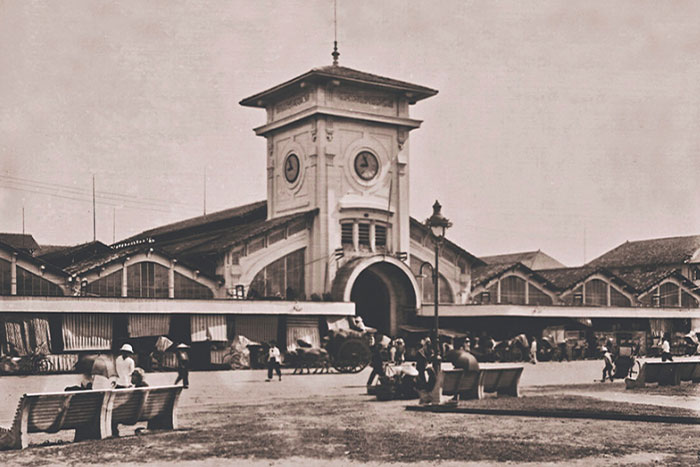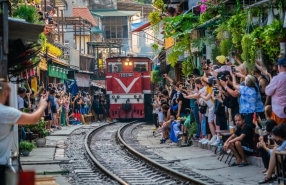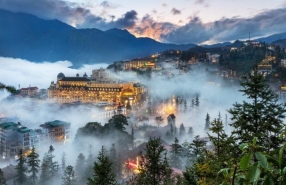
Welcome to the Ben Thanh Market, a bustling marketplace situated in District 1 of Ho Chi Minh City. With its origins dating back to 1912, this iconic market has become an unofficial symbol of the city, known for its vibrant atmosphere and diverse array of goods. Join me on a journey to discover What to do in Ho Chi Minh City.
1. What is the Ben Thanh Market ?
Spanning an area of 13,056 square meters, the Ben Thanh Market is located at the intersection of Phan Boi Chau, Phan Chu Trinh, Le Thanh Ton, and Quach Thi Trang streets in the vibrant Ben Thanh Ward. Here, you'll find a wide range of products, including clothing, fabrics, shoes, fashion items, handicrafts, fresh produce, fruits, and flowers.
What sets Ben Thanh Market Saigon apart is its historical significance. It predates the French occupation of Gia Dinh and was originally situated by the banks of the Ben Nghe River, near the entrance to the former Gia Dinh Citadel. The market's name, "Ben Thanh," derives from the nearby pier that served as a gateway for travelers and soldiers entering the citadel.
Today, the Ben Thanh Market continues to thrive as a hub of commerce and cultural exchange. Its vibrant atmosphere, bustling stalls, and enticing aromas make it a must-visit destination for both locals and tourists alike. So, come and immerse yourself in the energy and charm of Ben Thanh Market, where history meets modernity and shopping becomes an unforgettable experience.
2. When to visit the Ben Thanh Market ?
a. Early Morning Excitement:
For early risers and avid explorers, starting your day with a visit to the Ben Thanh Market is a fantastic choice for What to do in Ho Chi Minh City. Arriving in the morning allows you to witness the market come alive as vendors set up their colorful stalls and locals begin their daily shopping routine. Engage in friendly banter with the vendors, savor the aroma of freshly brewed Vietnamese coffee, and navigate the narrow aisles before the crowds arrive. This peaceful and authentic experience is perfect for capturing the essence of local life.
b. Weekdays for a Relaxed Stroll:
If you prefer a more leisurely and relaxed atmosphere, consider visiting the Ben Thanh Market on weekdays. While weekends tend to be busier with both locals and tourists, weekdays offer a quieter and more intimate experience. Take your time to browse through the vast array of goods, from traditional handicrafts to fashionable clothing, without feeling rushed. Engage in conversations with the friendly vendors, who are often more available to share stories and recommendations during weekdays.
c. Late Morning or Early Afternoon:
Timing is key when it comes to visiting Ben Thanh Market Saigon. To strike the perfect balance between avoiding the initial morning rush and enjoying a lively atmosphere, plan your visit for late morning or early afternoon. By this time, the market will have fully come alive, offering a bustling ambiance without the overwhelming crowds. You'll have the opportunity to witness the vibrant energy, sample delicious street food, and haggle for unique souvenirs to bring home.
d. The Evening Market Extravaganza:
As the sun sets, a whole new experience awaits at the Ben Thanh Market's outdoor night market. When darkness falls, the market comes alive with vibrant lights and a lively atmosphere. Indulge your taste buds with an array of street food delights, from sizzling grilled meats to savory noodles and refreshing tropical fruits. Stroll through the illuminated stalls, marvel at the colorful displays, and bargain for unique handicrafts and traditional items. The evening ambiance at the night market is simply enchanting and offers a whole different perspective on the market's charm.
3. The history of the Ben Thanh Market ?
a. The old market
Step back in time to the early days of Ben Thanh Market, a bustling trade hub in Ho Chi Minh City, Vietnam. Picture a market built with bricks, wooden frames, and thatched roofs, nestled along the riverbank. It was a vibrant scene, with a lively trade street and hidden houses lining the area. As spring arrived, the market came alive with a ritual ceremony and captivating water puppet performances. Traders from the sea would arrive by ferry, docking their boats along the riverbank and connecting with the vibrant marketplace.
In its early days, the area surrounding the market was home to around 100,000 residents, making the Ben Thanh Market the heart of the city. The riverbank was a sight to behold, filled with tightly packed boats and sampans, creating a floating city. However, the market area itself consisted merely of a row of empty tiled houses. It wasn't until the French occupation of Gia Dinh in 1859 that Ben Thanh Market began to take shape.
After the French established their presence in Southern Vietnam, they rebuilt the Ben Thanh Market in 1860 on its original site. The market was reconstructed with brick columns, wooden frames, and thatched roofs. It consisted of five sections, each dedicated to different goods, such as groceries, seafood, meat, food stalls, and miscellaneous items. The meat section stood out with its corrugated iron structure and a floor paved with green stones.
Situated on the southern bank of the Kinh Lon canal, Ben Thanh Market Saigon was strategically located. In front of the market stretched Charner Street, also known as Canton Street, as many Chinese traders from Guangdong province conducted their businesses there. Across the canal was Rigaul de Genouilly Street. The market's central location at the confluence of two waterways allowed boats to dock and unload passengers from both sides. Wooden bridges facilitated the movement of people through the market, creating a vibrant and bustling atmosphere.
As the years passed, the Kinh Lon canal became increasingly polluted, prompting the French to fill it up. By the late 1960s, the upper section of the canal was filled, and the city government later completed the process, merging the two old streets into one grand boulevard named Charner, or Kinh Lap Street. The market area, predominantly owned by Chinese, Indians, and French traders, flourished along this bustling street.
However, by 1911, the Ben Thanh Market had aged and deteriorated, posing a risk of collapse. To mitigate this danger, the market underwent partial demolition, with only the meat section retained due to its lightweight corrugated iron roof. Simultaneously, plans were set in motion to construct a new, larger market to accommodate the growing demands of trade. The chosen location was near the railway station to My Tho, which is where the present-day Ben Thanh Market stands, continuing its legacy as a vibrant and iconic trading hub in Ho Chi Minh City.
b. The new market
The bustling market we know today stood on what was once a swampy marsh called Marais Boresse. The French, with their determination, filled in the marsh, creating a space that would soon be transformed into a bustling hub of commerce. The market was thoughtfully designed with four sides, each bounded by its own street, creating a harmonious layout.
Construction of the market was no small feat and began in 1912, undertaken by the esteemed Brossard et Maupin company. By March 1914, the market was ready to unveil its grandeur to the world. The inauguration ceremony, known as "Tan Vuong Hoi" or the New King Festival, was a spectacle to behold. Fireworks illuminated the sky, parades adorned the streets, and an astonishing number of over 100,000 people from various provinces gathered to witness this momentous occasion.
One of the highlights of the opening day was a captivating tiger-fighting performance by a fearless young girl named Vo Thi Vuong. The story behind this spectacle is equally intriguing. In the process of clearing land and establishing rubber plantations in the northern province of Thu Dau Mot, a tiger had been caught in a trap and brought to Saigon. The fight between the tiger and the talented martial artist Vo Thi Vuong lasted from early morning until noon when Vuong skillfully pierced the tiger's vital point, emerging victorious.
In 1952, the Ben Thanh Market underwent a relocation to Bien Hoa, where the Fine Arts Workshop of Bien Hoa crafted exquisite bas-reliefs. These intricate artworks, measuring 2.2 x 1.5 meters for the larger ones and 2.0 x 1.4 meters for the smaller ones, were placed at the market's four entrances. The talented artist Le Van Mau led the creation of these masterpieces, receiving assistance from skilled craftsmen at the Fine Arts Workshop of Bien Hoa. Using traditional techniques, they mixed their own enamel colors for the ceramic products, resulting in unique shades and textures. The bas-reliefs depicted symbolic scenes, such as a catfish with a banana and a mandarin duck with a banana, adorning the different entrances of the market.
Although the market retained its name, Ben Thanh, it was commonly referred to as Saigon Market or New Market by the locals until before 1975. This distinction was necessary to separate it from the Old Market, which had transformed into a space solely for meat stalls. The market's transformation over the years, from a swamp to a vibrant trading center, is a testament to the resilience and entrepreneurial spirit of the people of Saigon. Today, Ben Thanh Market Saigon continues to thrive, attracting visitors from far and wide who come to experience its lively atmosphere and discover the rich history that lies within its bustling walls.
4. Travel tips before your visit
As you prepare for your upcoming visit to the Ben Thanh Market in Ho Chi Minh City, it's helpful to have some insider tips to ensure a smooth and enjoyable experience of What to do in Ho Chi Minh City. This bustling marketplace is a vibrant hub of activity, offering a treasure trove of goods, flavors, and cultural encounters. To make the most of your time there, here are some essential travel tips to consider.
Come Prepared with Vietnamese Dong:
While some vendors may accept major currencies or credit cards, it's advisable to have Vietnamese Dong (VND) on hand for your purchases at Ben Thanh Market. Currency exchange services are available nearby, ensuring you have the local currency ready. Having small denominations can also be beneficial for hassle-free transactions.
Practice Your Bargaining Skills:
Haggling is a common practice at Ben Thanh Market. Vendors often quote higher prices initially, expecting negotiations to take place. Engage in friendly bargaining to secure the best deals. Remember to maintain a respectful and polite approach while negotiating, as it adds to the overall experience and may result in successful discounts.
Explore Beyond the Main Building:
While the main building of Ben Thanh Market is a focal point for shopping, don't miss the opportunity to explore the surrounding areas. Venture into the outdoor stalls that stretch beyond the building, where you'll find additional vendors offering a wide range of products, local street food, and unique souvenirs. This extended market area provides a more diverse and authentic experience.
Sample the Local Cuisine:
Ben Thanh Market is a culinary paradise, with an abundance of street food stalls and small eateries. Take the opportunity to indulge in local Vietnamese cuisine, such as banh mi (Vietnamese baguette), pho (noodle soup), fresh spring rolls, and delicious tropical fruits. Follow your senses, and don't be afraid to try new flavors and dishes. Just ensure that the food is prepared hygienically and cooked thoroughly.
Stay Hydrated and Mindful of Food Safety:
With the lively atmosphere and enticing aromas, it's easy to lose track of time and forget to hydrate. Remember to drink plenty of water throughout your visit to stay refreshed and energized. Additionally, be mindful of food safety. Opt for freshly prepared dishes and avoid consuming raw or undercooked foods to prevent any potential health issues.
Respect Local Customs and Etiquette:
As with any travel experience, it's important to respect local customs and etiquette. Dress modestly, covering your shoulders and knees, to show cultural sensitivity. Be mindful of personal space and avoid touching goods unless you intend to purchase them. Additionally, always greet vendors and locals with a smile and a polite "Xin chào" (hello) or "Cảm ơn" (thank you).
By keeping these travel tips in mind, you'll be well-prepared to navigate the vibrant and bustling atmosphere of Ben Thanh Market. Embrace the cultural encounters, savor the flavors, and immerse yourself in the unique charm of this iconic marketplace.
5. Some often asked question about the Ben Thanh Market
What can I find at the Ben Thanh Market?
Ben Thanh Market offers a wide range of products, including clothing, fabrics, shoes, fashion accessories, handicrafts, souvenirs, fresh produce, fruits, flowers, spices, and local street food. It's a one-stop destination for shopping and experiencing the local culture.
Is it necessary to bargain at Ben Thanh Market?
Yes, bargaining is a common practice at Ben Thanh Market. Vendors often quote higher prices, expecting customers to negotiate. Engaging in friendly bargaining can help you secure better deals, but remember to be respectful and polite during the process.
Are there any nearby attractions to visit along with Ben Thanh Market?
Yes, Ben Thanh Market is centrally located, and there are several attractions in the vicinity. Some popular nearby sites include the Saigon Opera House, Notre Dame Cathedral, Independence Palace, and War Remnants Museum. Exploring these attractions along with Ben Thanh Market can provide a well-rounded experience of What to do in Ho Chi Minh City.
By following these tips, you can make the most of your visit to Ben Thanh Market and enjoy all that this historic landmark has to offer. If an authentic trip to Ben Thanh Market is what you are after, then don't hesitate to contact us : AUTOUR ASIA -
Vietnam Travel Agency to ensure you the voyage of your dream.











.jpg)

















